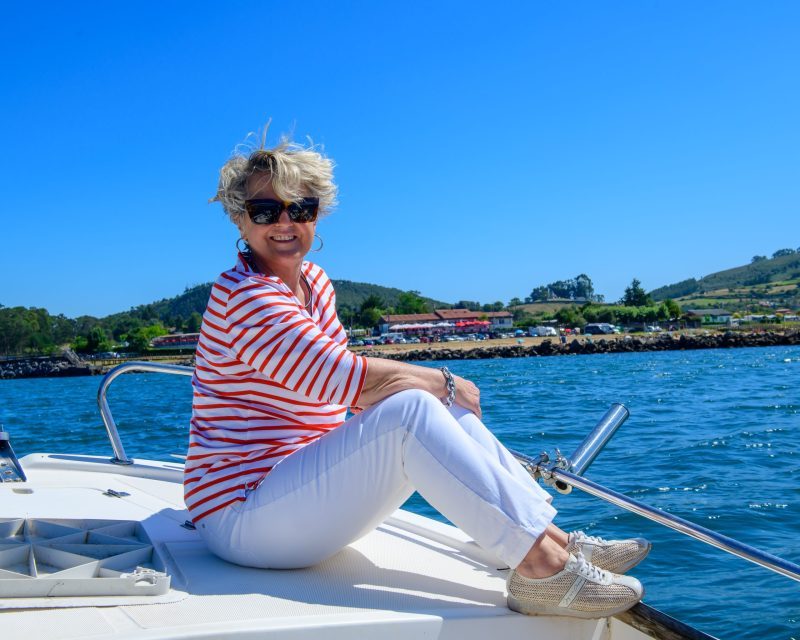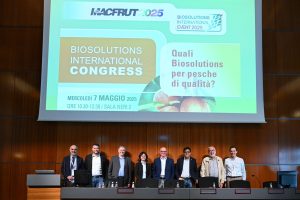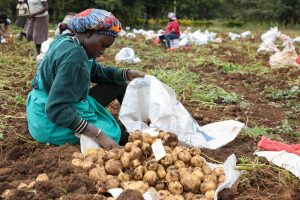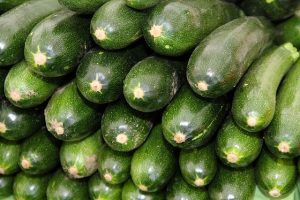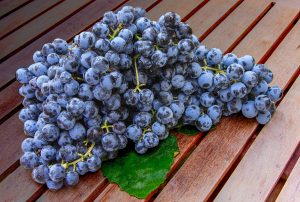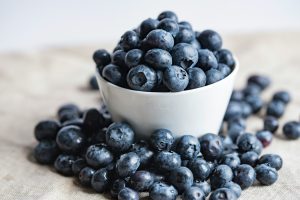Mª Fernanda Campa, Head of Quality Department of Greenyard Fresh Spain, was incredibly specific about her extensive agenda, which was rather a full-scale tour, in which I visited a cheese factory, a dairy, a cider factory, several Romanic churches and the theatre where she showed her prowess as an actress. In the evening, we had a few glasses of cider in the town of Tazones, the place where the Spanish king Charles I first landed in Spain.
Vital and energetic, she likes to enjoy her friendships, of which she has many, and she keeps up an intense social life. She also is very well-versed in the history of her land, to such an extent that we didn’t need a tourist guide, because she knows the dates, facts, architectonic styles and genealogy.
Her love for canoeing meant that we started the day off with a trip down the Villaviciosa estuary, from the installations of the cider factory, El Gaitero, almost to the Cantabrian Sea, not without some concern due to the imminent dropping tide that could have made us run aground.
What memories of the Villaviciosa estuary do you have?
This estuary represents part of the happiest moments of my teenage years. From the age of 12 to 22 years I practiced this sport. I always longed to win the Villa de Villaviciosa Regatta and I actually did in 1979, thanks to my trainer Juan Luis Jurado, who will always live on in the memories of those who knew him.
It seems that you still have many friendships from that time
Yes, a large part of my friends date back to my time at primary and secondary school. In my youth I was surrounded by good friends; it was a very happy time. I have particularly fond memories of my teacher Radis, who belonged to the ‘Sección Femenina’ and was well before her time because she brought us political magazines such as Cambio 16 and she taught us about democracy.
How many times have you been told you are a very elegant woman?
(Laughter.) A few. I always remember the words of a university friend who told me: “If truth be told, you aren’t pretty, but when you enter a room everyone has to look at you” and I knew how to exploit this.
I like clothes and dressing up. Mentally for me, the props mean a change of scenery. As entrepreneur Mario Conde said: “Clothing is an act of respect towards the person you are with.” I have experienced this in my home: my grandmother was a very stylish seamstress who spent her nights sewing and was a real trend-setter in Villaviciosa. She was a spectacular woman, way ahead of her time. I have often thought that my life should be a tribute to her, as she died when she was young in a car accident.
My mother also sewed and I have always lived amongst fabric and needles. In fact, I still go shopping with her and, in spite of her age, she still keeps up-to-date with the latest fashions.
It seems that you have a very intense social life when you come to Asturias
Yes, during the holidays part of my gang meet up on Thursdays. I used to call this meeting “The Thursday widows” following the novel of the same name by the Argentinean writer Claudia Piñeiro and the film based on it, directed by Marcelo Piñeyro, but my “girls” became a little concerned about the name and now the WhatsApp group is called “the Thursday girls.”
What led you to study Agricultural Technical Engineering?
We lived in a rural environment; my father had livestock, but I knew that I wasn’t going to continue with the family legacy and I am an only child. This setting, so close to the land, made me fall in love with the work carried out by the Agricultural Extension technicians who visited our house. I liked everything they did: advice, reports, but particularly the proximity to the producers and the affection they showed them. So, I knew exactly what I wanted to do, and at the age of 18, I went to Leon to study Agricultural Technical Engineering.
In your profile, you have a highly significant photo: a small chapel by the roadside; could you explain its meaning?
It is the Chapel of San Climenti (Clemente) in a forest. I am a believer in my own way, although I do not agree with the status and power of the church. I have a special devotion for this saint, whose chapel, which dates back to the times of King Ordoño, had disappeared. The village’s festival association carried out a great job of recovering the cultural patrimony, but they couldn’t find an image for this little chapel, so I moved heaven and earth until I found one in a shop in Murcia and I brought it back here by plane. And we now have the San Climenti chapel.
Are you involved in any other activity or festival in the village?
Of course! I am involved in almost everything that is celebrated. I am very fond of the ‘Puya´l ramu’, an ancestral offering that was made to Mother Earth after the harvest and that with Romanisation was adapted to the religious festivities. A branch leaves each house or district, moving towards the church, accompanied by a procession with bagpipers. At the end of the mass the ‘Puya’l ramu’ (auction of offerings) is carried out in the porch of the church and the money obtained is used by the festival brotherhoods. For many years, when I was a young girl, I carried ‘ramu’ to San Xuan, dressed in the traditional costume. I remember the night before the offering I couldn’t sleep because of the excitement. I always went dressed up in the traditional outfit.
I am very surprised to find that you are a theatre-lover and even more curiously, someone who showed her prowess as an actress. Which play do you have fondest memories of?
(Sigh.) God would have to give me another life to return to the stage! When I was 24 or 25, I played a woman of 80, very well characterised by my friend Carmen, whose spirit is deeply entrenched in Hollywood, and I played an 80-year old woman in the play ‘The Father’, by the Swedish playwright Strindberg.
I believe that you also write
Yes, I also love to write. I always say that I am worth more ‘for what I write’. Knowing how to write and describe helps me a great deal in my work. Also, writing is a way of expressing my feelings. At the party celebrating the 50 years of my clique, I wrote a short column in memory of it that everyone liked: “Living to tell the story”. And many years ago I wrote the programme for the festival of Nuestra Señora del Portal.
What is your favourite reading material?
Without any doubt, historical novels. I love medieval history from King Pelayo onwards. I have studied the Kingdom of Castilla y Leon from its Asturian origins until the Catholic Monarchs. Two of my favourite characters are King Ramiro I and Joanna the Mad, who was not mad at all. Here in Villaviciosa, the main historical milestone was the arrival of the Spanish king Charles I from Ghent to the port of Tazones. Although there are historians who point out that his ships went aground in the estuary because a storm played a dirty trick on him.













